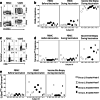Activation, dysfunction and retention of T cells in vaccine sites after injection of incomplete Freund's adjuvant, with or without peptide
- PMID: 23657629
- PMCID: PMC3813823
- DOI: 10.1007/s00262-013-1435-5
Activation, dysfunction and retention of T cells in vaccine sites after injection of incomplete Freund's adjuvant, with or without peptide
Abstract
We conducted a randomized clinical trial in 45 patients with resected AJCC stage IIB-IV melanoma to characterize cellular and molecular events at sites of immunization with incomplete Freund's adjuvant (IFA) alone, or a melanoma vaccine in IFA. At a primary vaccine site, all patients received a multi-peptide melanoma vaccine in IFA. At a replicate vaccine site, which was biopsied, group 1 received IFA only; group 2 received vaccine in IFA. Lymphocytes isolated from replicate vaccine site microenvironments (VSME) were compared to time-matched peripheral blood mononuclear cells (PBMC) in ELISpot and flow cytometry assays. Compared to PBMC, the VSME had fewer naïve and greater proportions of effector memory CD8(+) T cells (TCD8). The vast majority of TCD8 within the VSME were activated (CD69(+)), with a concentration of antigen-specific (tetramer(pos)) cells in the VSME, particularly in vaccine sites with peptide (group 2). CXCR3(+) lymphocytes were concentrated in the VSME of all patients, suggesting IFA-induced chemokine recruitment. TCD8 expression of retention integrins αEβ7 and α1β1 was elevated in VSME, with the highest levels observed in antigen-specific cells in VSME containing peptide (group 2). TCD8 retained in the VSME of both groups were strikingly dysfunctional, with minimal IFN-γ production in response to peptide stimulation and few tetramer(pos) cells producing IFN-γ. These data suggest that vaccine-induced selective retention and dysfunction of antigen-specific TCD8 within VSME may represent a significant mechanism underlying transient immune responses and low clinical response rates to peptide vaccines administered in IFA.
Conflict of interest statement
The authors declare that they have no conflict of interest.
Figures





Similar articles
-
A multipeptide vaccine plus toll-like receptor agonists LPS or polyICLC in combination with incomplete Freund's adjuvant in melanoma patients.J Immunother Cancer. 2019 Jun 27;7(1):163. doi: 10.1186/s40425-019-0625-x. J Immunother Cancer. 2019. PMID: 31248461 Free PMC article. Clinical Trial.
-
Incomplete Freund's adjuvant reduces arginase and enhances Th1 dominance, TLR signaling and CD40 ligand expression in the vaccine site microenvironment.J Immunother Cancer. 2020 Apr;8(1):e000544. doi: 10.1136/jitc-2020-000544. J Immunother Cancer. 2020. PMID: 32350119 Free PMC article.
-
Characterization and comparison of innate and adaptive immune responses at vaccine sites in melanoma vaccine clinical trials.Cancer Immunol Immunother. 2021 Aug;70(8):2151-2164. doi: 10.1007/s00262-020-02844-w. Epub 2021 Jan 16. Cancer Immunol Immunother. 2021. PMID: 33454795 Free PMC article. Clinical Trial.
-
Immunogenicity in humans of a transdermal multipeptide melanoma vaccine administered with or without a TLR7 agonist.J Immunother Cancer. 2021 May;9(5):e002214. doi: 10.1136/jitc-2020-002214. J Immunother Cancer. 2021. PMID: 34035112 Free PMC article. Clinical Trial.
-
Cancer vaccines: Trafficking of tumor-specific T cells to tumor after therapeutic vaccination.Int J Biochem Cell Biol. 2014 Aug;53:46-50. doi: 10.1016/j.biocel.2014.04.019. Epub 2014 May 2. Int J Biochem Cell Biol. 2014. PMID: 24796845 Free PMC article. Review.
Cited by
-
A multipeptide vaccine plus toll-like receptor agonists LPS or polyICLC in combination with incomplete Freund's adjuvant in melanoma patients.J Immunother Cancer. 2019 Jun 27;7(1):163. doi: 10.1186/s40425-019-0625-x. J Immunother Cancer. 2019. PMID: 31248461 Free PMC article. Clinical Trial.
-
Chemokine receptor patterns in lymphocytes mirror metastatic spreading in melanoma.J Clin Invest. 2016 Mar 1;126(3):921-37. doi: 10.1172/JCI80071. Epub 2016 Feb 8. J Clin Invest. 2016. PMID: 26854930 Free PMC article.
-
Immunologic hierarchy, class II MHC promiscuity, and epitope spreading of a melanoma helper peptide vaccine.Cancer Immunol Immunother. 2014 Aug;63(8):779-86. doi: 10.1007/s00262-014-1551-x. Epub 2014 Apr 23. Cancer Immunol Immunother. 2014. PMID: 24756419 Free PMC article.
-
Safety and tolerability evaluation of the use of Montanide ISA™51 as vaccine adjuvant: A systematic review.Hum Vaccin Immunother. 2016;12(1):159-69. doi: 10.1080/21645515.2015.1071455. Epub 2015 Sep 17. Hum Vaccin Immunother. 2016. PMID: 26378866 Free PMC article.
-
Survivin-targeted immunotherapy drives robust polyfunctional T cell generation and differentiation in advanced ovarian cancer patients.Oncoimmunology. 2015 May 7;4(8):e1026529. doi: 10.1080/2162402X.2015.1026529. eCollection 2015 Aug. Oncoimmunology. 2015. PMID: 26405584 Free PMC article.
References
-
- Schwartzentruber DJ, Lawson DH, Richards JM, Conry RM, Miller DM, Treisman J, Gailani F, Riley L, Conlon K, Pockaj B, Kendra KL, White RL, Gonzalez R, Kuzel TM, Curti B, Leming PD, Whitman ED, Balkissoon J, Reintgen DS, Kaufman H, Marincola FM, Merino MJ, Rosenberg SA, Choyke P, Vena D, Hwu P. gp100 Peptide vaccine and interleukin-2 in patients with advanced melanoma. N Engl J Med. 2011;364(22):2119–2127. doi: 10.1056/NEJMoa1012863. - DOI - PMC - PubMed
-
- Slingluff CL, Jr, Petroni GR, Chianese-Bullock KA, Smolkin ME, Hibbitts S, Murphy C, Johansen N, Grosh WW, Yamshchikov GV, Neese PY, Patterson JW, Fink R, Rehm PK. Immunologic and clinical outcomes of a randomized phase II trial of two multipeptide vaccines for melanoma in the adjuvant setting. Clin Cancer Res. 2007;13(21):6386–6395. doi: 10.1158/1078-0432.CCR-07-0486. - DOI - PubMed
Publication types
MeSH terms
Substances
Grants and funding
LinkOut - more resources
Full Text Sources
Other Literature Sources
Medical
Research Materials

